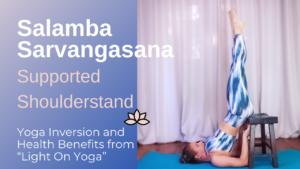What’s up everyone. I’m Courtney Bell and this is Yoga Current. We all experience wonderful health benefits from yoga. This blog shares information about how yoga targets specific health functions and creates therapeutic effects on the human endocrine system. Namely, how the yoga pose called Supported Shoulderstand (Salamba Sarvangasana) effects the Thyroid and Parathyroid glands.
What is the Endocrine System?
The Endocrine System is a series of glands within the body that produce hormones. Each gland absorbs specific nutrients from the blood stream and then secretes hormones through the bloodstream that signal various tissues to function. Consuming a well-balanced diet with the right nutrients for the glands to absorb is an important part of keeping your endocrine system healthy to produce the necessary hormones for life. These nutrients include Omega-3, Omega-6, and Omega-9 oils, Garlic, Calcium, Vitamin B and B complex, and Vitamin C.
The endocrine system controls various functions including:
- Respiration
- Metabolism
- Reproduction
- Sensory perception
- Movement
- Sexual development
- Growth
When the endocrine system does not function properly and the glands do not produce the right amount of hormones, the body can develop diseases that affect many aspects of life. Symptoms of hormonal issues include weight gain, irregular monthly cycles, PMS, low back ache, low libido, insomnia, fatigue, mood swings, thyroid imbalances, fertility issues, hot flashes, poor immune function, anxiety, depression and blood sugar imbalances.
The endocrine system is comprised of 7 glands within each person:
- Hypothalamus – part of the brain that works with the Pituitary to regulate the activity of glandular system
- Pituitary – part of the brain that works with the Hypothalamus to regulate the activity of glandular system
- Thyroid – located in the neck, the Thyroid is a butterfly-shaped gland that plays a major role in the metabolism, growth and development of the human body
- Parathyroids – located in the neck, the Parathyroid is four small glands that continuously monitor and regulate blood calcium levels
- Adrenals – located on top of both kidneys, the Adrenal glands are small, triangular-shaped glands that help regulate your metabolism, immune system, blood pressure, and response to stress
- Pineal – located in the brain, the Pineal gland produces melatonin and plays a central role in the regulation of circadian rhythm (the roughly 24-hour cycle of biological activities associated with natural periods of light and darkness).
- Ovaries – located in the pelvis, the Ovaries are the female counterpart to the Testes, producing the estrogen and progesterone
- Testes – located in the pelvis, the Testes are the male counterpart to the Ovaries, making testosterone
Health Benefits of Yoga on the Endocrine System
In Light on Yoga, Iyengar states, “Amazingly enough, many of the yoga asanas have a direct effect on the glands and help them to function properly.”
The way this happens is through subtle compressions which cause pressurization and depressurization. It is very similar to how the potency of touch in Osteopathic Manipulative Therapy is used in clinical treatment. Through methods of layered palpation, patients can be diagnosed, treated, and monitored.
Similarly, when focused on sequences, alignment, and action of positions in Yoga, the practice can be directed to tone and nourish the internal organs. All kinds of yoga sequence can benefit the adrenal glands regulation of stress, metabolism, and blood pressure. Vibrations from rhythmic breathing can stimulate the thyroid and parathyroids. Inverted positions also benefit from the venous blood flow in mild and full inversions.
Health Benefits of Yoga Shoulder Stand
I have been a licensed massage therapist since 2005, as well as a yoga instructor. When you understand the functions of the body and the ability of trained touch to benefit musculoskeletal, circulatory, respiratory, digestive, and endocrine systems, it is easy to apply the knowledge to yoga asana practice.
By following yoga sequences, alignment, and action cues you are able to train yourself to provide “therapeutic touch” for your system. Preparing your body to learn Shoulderstand, involves a sequence of poses that develop the musculoskeletal actions of the shoulderblades retracting– pulling the shoulder blades (the scapulae) in towards the spine without shrugging up towards the ears. Through a variety of sequencing, you learn this action and its effects in many positions with varying relationships to gravity. The Shoulderstand then guides you to use your hands and feet for proper support to invert your body with compression in the throat that stimulates circulation through the thyroid and parathyroids. It is called a “Chin Lock” or ” Throat Lock,” or “Jalandhara Bandha.”
Therapeutic Preparation and Practice of Shoulderstand
You can access my yoga video series of Shoulderstand Cycle– preparation and practice– on Patreon. I created this series in January, 2021:
- Video One – 30min yoga class | preparation
- Video Two – 40min yoga class | half-lotus floor routine – shoulderstand cycle part one
- Video Three – 30min yoga class | big-toe-clasp floor routine – shoulderstand cycle part two
- Video Four – 20min yoga class | in production
Contraindications to the practice of the inverted position of Shoulderstand include high blood pressure, glaucoma, obesity, and neck/spinal injury.
I also have created two supplementary videos for YouTube!
Watch the videos at Yoga Current here
- Prep for Shoulderstand
- Salamba Sarvangasana
Subscribe to my YouTube channel here
- Help me reach my goal of 4000 watch hours in 2021
- Watch, Like, and Share my videos






